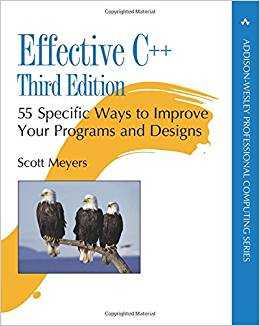标签:file ice evel time source osi art typename custom

Scott Meyers is one of the world‘s foremost authorities on C++, providing training and consulting services to clients worldwide. He is the author of the best-selling Effective C++ series of books (Effective C++, More Effective C++, and Effective STL) and of the innovative Effective C++ CD. He is consulting editor for Addison Wesley‘s Effective Software Development Series and is a founding member of the Advisory Board for The C++ Source (http://www.artima.com/cppsource). He holds a Ph.D. in Computer Science from Brown University. His web site is http://www.aristeia.com.
Item 1: View C++ as a federation of languages. 11
Item 2: Prefer consts, enums, and inlines to #defines. 13
Item 3: Use const whenever possible. 17
Item 4: Make sure that objects are initialized before they’re used. 26
Item 5: Know what functions C++ silently writes and calls. 34
Item 6: Explicitly disallow the use of compiler-generated functions you do not want. 37
Item 7: Declare destructors virtual in polymorphic base classes. 40
Item 8: Prevent exceptions from leaving destructors. 44
Item 9: Never call virtual functions during construction or destruction. 48
Item 10: Have assignment operators return a reference to *this. 52
Item 11: Handle assignment to self in operator=. 53
Item 12: Copy all parts of an object. 57
Item 13: Use objects to manage resources. 61
Item 14: Think carefully about copying behavior in resource-managing classes. 66
Item 15: Provide access to raw resources in resource-managing classes. 69
Item 16: Use the same form in corresponding uses of new and delete. 73
Item 17: Store newed objects in smart pointers in standalone statements. 75
Item 18: Make interfaces easy to use correctly and hard to use incorrectly. 78
Item 19: Treat class design as type design. 84
Item 20: Prefer pass-by-reference-to-const to pass-by-value. 86
Item 21: Don’t try to return a reference when you must return an object. 90
Item 22: Declare data members private. 94
Item 23: Prefer non-member non-friend functions to member functions. 98
Item 24: Declare non-member functions when type conversions should apply to all parameters. 102
Item 25: Consider support for a non-throwing swap. 106
Item 26: Postpone variable definitions as long as possible. 113
Item 27: Minimize casting. 116
Item 28: Avoid returning “handles” to object internals. 123
Item 29: Strive for exception-safe code. 127
Item 30: Understand the ins and outs of inlining. 134
Item 31: Minimize compilation dependencies between files. 140
Item 32: Make sure public inheritance models “is-a.” 150
Item 33: Avoid hiding inherited names. 156
Item 34: Differentiate between inheritance of interface and inheritance of implementation. 161
Item 35: Consider alternatives to virtual functions. 169
Item 36: Never redefine an inherited non-virtual function. 178
Item 37: Never redefine a function’s inherited default parameter value. 180
Item 38: Model “has-a” or “is-implemented-in-terms-of” through composition. 184
Item 39: Use private inheritance judiciously. 187
Item 40: Use multiple inheritance judiciously. 192
Item 41: Understand implicit interfaces and compile-time polymorphism. 199
Item 42: Understand the two meanings of typename. 203
Item 43: Know how to access names in templatized base classes. 207
Item 44: Factor parameter-independent code out of templates. 212
Item 45: Use member function templates to accept “all compatible types.” 218
Item 46: Define non-member functions inside templates when type conversions are desired. 222
Item 47: Use traits classes for information about types. 226
Item 48: Be aware of template metaprogramming. 233
Item 49: Understand the behavior of the new-handler. 240
Item 50: Understand when it makes sense to replace new and delete. 247
Item 51: Adhere to convention when writing new and delete. 252
Item 52: Write placement delete if you write placement new. 256
Item 53: Pay attention to compiler warnings. 262
Item 54: Familiarize yourself with the standard library, including TR1. 263
Item 55: Familiarize yourself with Boost. 269
C++学习书籍推荐《Effective C++ 第三版(英文)》下载
标签:file ice evel time source osi art typename custom
原文地址:https://www.cnblogs.com/awesome-share/p/10046756.html